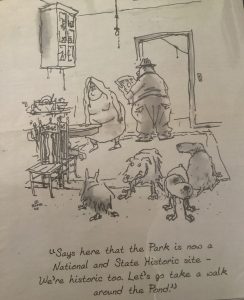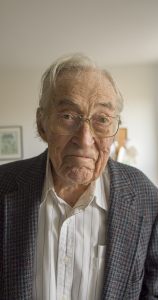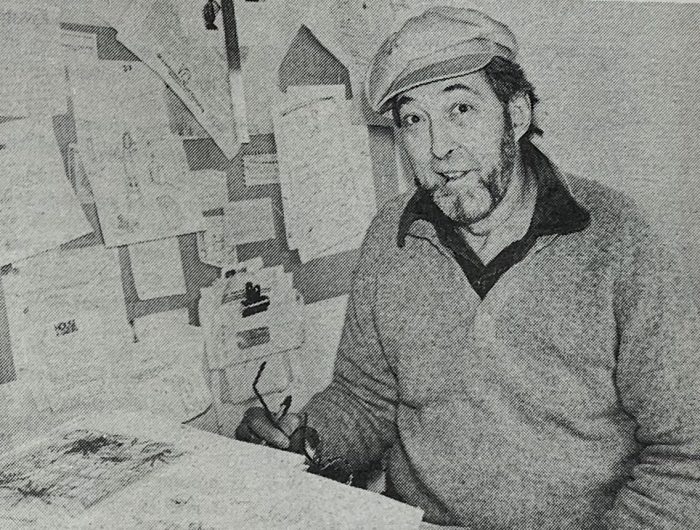The New Yorker cartoonist and former Stony Brook resident George Booth died on Nov. 1 at his home in Brooklyn. He was 96. The cartoonist died a few days after his wife, Dione, who passed away on Oct. 26.

According to his obituary in The New York Times, the cause of his death was complications of dementia.
Booth was known for his cartoons that featured various quirky characters depicted as cats, dogs, mechanics, cave dwellers and churchgoers in the weekly magazine over 50 years. The magazine’s unofficial mascot was a bull terrier that appeared in several of his cartoons.
While living in Three Village, Booth and his work was featured in The Village Times and The Village Times Herald. In 1980, he was named the paper’s Man of the Year in Media.
According to the 1980 article, the former Stony Brook resident lived in a house that once belonged to a sea captain. In the interview, he said fellow residents “let me put them in my cartoons.” However, he didn’t divulge any names.
He also received inspiration from his wife.
“Dione has been an education to me on the subject of plants, minuets and pussycats,” he said.
In The Village Times article, he said he and his two brothers grew up in Missouri, where his father trained him as a printer’s devil, an apprentice in a printing establishment. His mother was a cartoonist and musician, and she served as inspiration for his character Mrs. Ritterhouse.
In the 1980 article, he said he developed an interest in auto mechanics while living in Cold Spring Harbor. He had a Model A that always had issues.
“In order to keep it running I had to live at Bohaty’s garage in Centerport,” he said.
Among his favorite artists were Fred Lasswell, who created the “Snuffy Smith” comic strip, and portrait artist Thomas Hart Benton.
When asked which one of his cartoons he would put in a time capsule, he said “Ip Gissa Gul,” which means “ape gets a girl.”

He was born in Cainsville, Missouri, on June 28, 1926, according to The New York Times obituary and grew up on a farm near Fairfax, Missouri. His parents were teachers.
Booth was drafted in 1944 and joined the U.S. Marine Corps. Eventually he became a cartoonist for the Marine magazine Leatherneck. He attended the Chicago Academy of Fine Arts, the Corcoran School of Art in Washington, D.C., and the School of Visual Arts in New York City, on the G.I. Bill. After moving to New York in 1952, he sold art to publications such as Collier’s, Look and The Saturday Evening Post. The cartoonist and his wife married in 1958.
Booth sold his first cartoon to The New Yorker in 1969. He also illustrated children’s books, including “Wacky Wednesday” by Dr. Seuss (as Theo LeSieg) and “Here, George!” by Sandra Boynton. His art career also led him to advertising campaigns, greeting cards and animation.
In recognition of his work, Booth won the Gag Cartoon Award by the National Cartoonists Society in 1993, and the society’s Milton Caniff Lifetime Achievement Award in 2010. He was an honorary member of Colgate University’s Class of 1939 and was awarded an honorary doctorate of fine arts from Stony Brook University in 2003,. He is the subject of “Drawing Life,” part of The New Yorker Documentary series.
Local reflections
Jeffrey Levinton, of Stony Brook, said he and his wife, Joan Miyazaki, were the Booths’ neighbors. He described George Booth as a kind man. The cartoonist would invite Levinton’s son Nathan when he was younger to his Stony Brook studio to see his cartoons.
Levinton added George Booth loved to tell stories and jokes.
“They often had punchlines I did not understand, but George would laugh out loud after telling them,” Levinton wrote.
He remembers one of The New Yorker covers Booth showed them.
“Dracula and a cat at the dinner table – cat with a bowl of milk and Dracula with a bowl of blood,” he said. “George also had a truly amazing pair of drawings of a carnival ride, built in his backyard — you could see the steeple of the church on Christian Avenue. The ride was physically impossible, but George had an explosion diagram of all the impossible parts of a ride where a guy zoomed about the yard and landed in a couch. This masterpiece is apparently lost.”
Levinton remembered a story that Dione Booth told him about her husband that he feels reveals the cartoonist’s character best.
“They met and George asked her out,” he said. “He told her to wear a formal dress and he appeared at her door, also dressed formally. He took her out on a very expensive night in Manhattan, night clubs and the rest. Then she didn’t hear from him for a month, and he called again, making the same invitation, same night on the town. And again. She thought, ‘Wow, I have met a rich guy.’ But he was only inviting her after selling a cartoon, blowing the whole fee on a night out. As Dione said, ‘I thought he was rich but eccentric, and I learned that he was only eccentric.’”

East Setauket architect Robert Reuter considered George Booth a treasured friend and worked in the same Stony Brook building with the cartoonist where they both had studios.
“It was sometimes just hilarious because I would be working on the other side of the wall, and all of a sudden there would be a bellow of laughter where he had drawn something or written something or whatever that just cracked him up so much,” Reuter said.
He would often get a peek at some of The New Yorker cartoons, and Booth gave Reuter’s son, Jordan, drawing lessons “from the time he could hold the pencil.”
The architect said the cartoonist was a generous man, creating illustrations for Frank Melville Memorial Park and other organizations and people.
Reuter said over the years Booth used BIC and similar pens because he liked the “blobby ink.” Often he would draw a few versions of a character and then choose one to put into the cartoon by copying and pasting. He also was known for using Wite-Out.
Reuter said Dione was a brilliant gardener. “There was a time when her abilities as a decorator and designer, especially in landscapes, was highly revered.”
Nancy Bueti-Randall, of Stony Brook, met the couple in the 1980s when she lived in Brooklyn and was running a studio sale in St. James, and they both bought a piece of jewelry each from her. She reconnected with them when she moved to Three Village nearly 30 years ago.
“They were such an integral part of the community,” she said.
Bueti-Randall and Dione Booth belonged to the Creative Women’s Group. At each meeting, women would talk about their careers and creative pursuits.
Dione was a delightful, kind and loving person who was extremely supportive of her husband’s work and devoted to him, Bueti-Randall said. She added George consulted with his wife often.
She remembered Dione’s gardening, too, and said she made “flower arrangements that would knock your socks off.”
Bueti-Randall was also fortunate to see George Booth’s drawings in progress, and she said he always had a full workload.
“George was the most humble person,” she said. “You would never guess this man was at the top of his field.”
Bueti-Randall said Booth would go to 7-Eleven in the morning, and sit in his car for about an hour and observe people.
“He loved all kinds of people, and he was just an observer of life,” she said. “That’s what he brought to his cartoons. That was part of his work, just to sit there and observe and try to see something that was funny to him or ironic.”
The Ward Melville Heritage Organization president, Gloria Rocchio, and her husband, Richard, knew Booth and his wife. Rocchio said the cartoonist would read children stories and children’s books at the Educational & Cultural Center during WMHO’s Hot Cocoa Series.
“Richard and I admired him,” she said. “He had a very interesting life. He and his wife lived in Stony Brook for a very long time, and they wanted to be very unassuming. To many people George was a world-renowned cartoonist, and rightly so, but to many of us in Stony Brook he was just our friend George.”
George and Dione Booth leave behind their daughter Sarah, who lives in Brooklyn.





